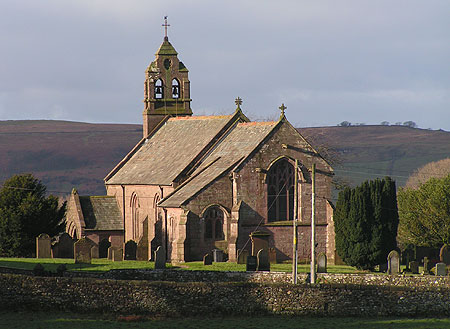
The village of Lamplugh lies just East of the modern road and midway from Egremont to Cockermouth, about 9 miles from Whitehaven. The roman road also passed through here so the place has considerable age with the name Lamplugh probably being of Celtic origin.* There was also a stone circle here about 100 paces across made from none-local stones 4 feet high. This partially survived into the 19th century on the Stockhow hall estate. The find of a stone hammer also indicates ancient habitation of the area.

One notable feature of Lamplugh is the church of St. Michael with its external bell tower containing two bells, one of which is a well preserved 15th century bell with an inscription that it was made for Thomas Lamplugh. This is older than most of the present church which was largely rebuilt in 1870. An older church had a thatched roof until 1658, and a leaking lead roof over the chancel was replaced by slate when more restoration was done in 1771. In the east wall are three well carved gargoyles around the window which, presumably, were from the older church which is said to have had fine carved stonework.
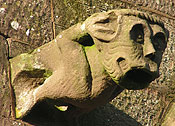
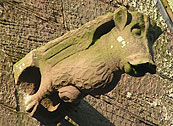
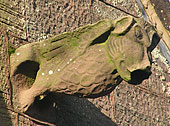
The church also has a stone altar thought to be from before the time when they were forbidden and destroyed in many churches. The parish registers also record some very unusual causes of death around 1660, including; death in a dual between a frying pan and pitchfork, being frightened to death by fairies and even Mrs. Lamplugh's cordial water apparently accounted for two. Punishment was also fatal with 3 old women drowned during trial as witches, 7 hanged for tampering with the coinage and even 2 begging vagrants "worried" by the squire's dog.
The first lord of the manor to take the name was Sir Robert de Lamplugh in the middle of the 12th century who had the church moved to its present location. He was followed by a long succession of Lamplughs many who were knighted for valour in the field of battle. Several of the family were Sheriffs of Cumberland. We can see from an old arch, that formed the gateway to Lamplugh hall, the inscribed arms of John Lamplugh 1595. The heraldic colours were a yellow background with a black fleury cross.
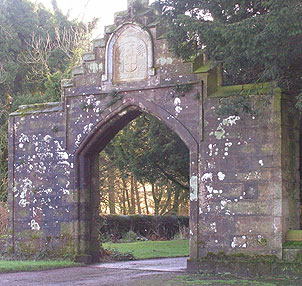
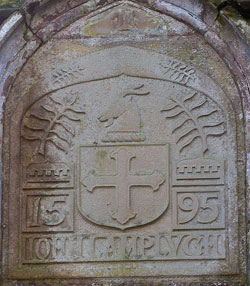
Another member of the family was Thomas Lamplugh, Archbishop of York (1615-1691), who gained his promotion whilst Bishop of Exeter, for preaching loyalty to James II on the arrival of William of Orange. As with Grindall and Sandys before him, he was educated at St. Bees.
The second half of the nineteenth century brought industry to this quiet rural location when the ground was exploited for limestone and high grade iron-ore, two of the three main ingredients for the blast furnaces, to produce pig iron which in turn could be used in the Bessemer process of steel production. The mining and quarrying also brought the railway in 1864 although this was removed in 1980.
The parish also includes the small hamlets of Murton (moor town) and Kelton named after Ketel grandson of the first baron of Kendal, Ivo de Talebois. This area contained the original pre-norman church hence the name of the mining village of Kirkland.
Lamplugh is over-looked from the East by the fells of Knock Murton and Blake fell which cradle the small trout lake of Cogra Moss. Tourism is catered for by the Inglenook Caravan and campsite.
*Note: The name Lamplugh in Bulmer's 1901 directory is thought to derive from Irish celtic Glan Flough meaning wet dale suggested by Denton. Not very convincing as that would apply to any valley in Cumbria. The Oxford Names Companion gives it as c.1150 from celtic nant + bluch meaning bare valley. Also improbable as an old rhyming couplet states "A squirrel could hop from tree to tree - From Lamplugh Fells to Moresby" - so hardly bare. A more recent suggestion in two books about the parish is that it is from welsh celtic Llan originally meaning enclosure then later church and plwyf for parish or area. The second syllable is rejected by The English Place-name sociey's book because of the throaty ending sound in so many spellings. Lamplou c.1150,Lamplogh c.1160, Lamplo c.1181,Landplo c.1200, Lamplod 1201-30, Lamploch c.1210, Langplogh, Langplugh c.1292, Langeplogh 1309, Landplewe 1419, Lamplegh 1570, Lamplugh 1580, Lamplage 1657. My own guess is that as celtic names often describe the geography, the second syllable may have been pwll which is virtually un-pronounceable by a non-celtic tongue hence the variation of ancient spellings from Lanplo to Lanploch. Hence it might have originally been Llanpwll the enclosed settlement in the hollow.
© WAWL 2007